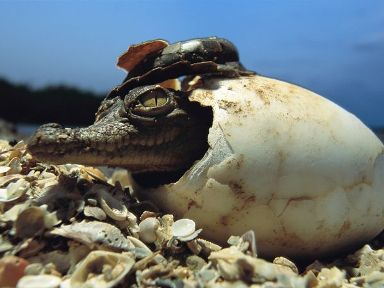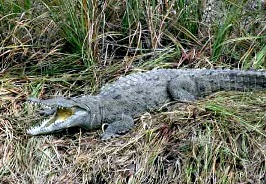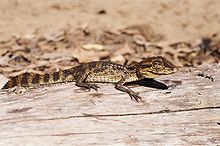So You Want to Know About the Birds and the Bees...
As seen in the
digestive and circulatory systems, reproduction for crocodilians is
observed to be more complex than any other reptile due to complex
nesting and courtship methods. Crocodilians reproduce sexually
between a male and female and it has been seen that courtship takes
place during the months of January and February. Du ring the
courtship, males must first attract a mate and they do so by
performing a series of head slaps on the water’s surface. If a
nearby female is interested, she will raise her head and arch her
tail to let the male know she is interested. Once a male recognized
a female has responded to him, he will make a complex vibration with
his body and will engage the female. After the male has engaged the
female, a series of events will take place, such as rubbing snouts
and submerging, with sexual intercourse being the final event. After
fertilization has taken place the male will then leave the female
and continue about his life until the next mating season comes around,
but the female has a long process ahead of her.
ring the
courtship, males must first attract a mate and they do so by
performing a series of head slaps on the water’s surface. If a
nearby female is interested, she will raise her head and arch her
tail to let the male know she is interested. Once a male recognized
a female has responded to him, he will make a complex vibration with
his body and will engage the female. After the male has engaged the
female, a series of events will take place, such as rubbing snouts
and submerging, with sexual intercourse being the final event. After
fertilization has taken place the male will then leave the female
and continue about his life until the next mating season comes around,
but the female has a long process ahead of her.
Nesting
takes place during the months of April and early May when the wet
season is in full affect. The female must build a nest for her eggs
that must be high above water level because the crocodilian eggs
will not survive flooding. Female crocodile s will often build their
nests out of sand, mud, and surrounding vegetation. It is crucial
that the female build the nest with enough material that it will
have small temperature variation in it because the sex of the
hatchlings is dependent on temperature and will not be determined
immediately after the eggs are laid.
s will often build their
nests out of sand, mud, and surrounding vegetation. It is crucial
that the female build the nest with enough material that it will
have small temperature variation in it because the sex of the
hatchlings is dependent on temperature and will not be determined
immediately after the eggs are laid.
Once the female lays her batch, which normally range from 20 to 60
eggs, she will cover the hole or mound that she has created for her
nest and will let them incubate until they hatch. Mo st
females do not remain around their nests, but they will return
towards the end of incubation to listen for the cries of the new
hatchlings and will uncover the nest to assist them in getting out.
Once the new hatchlings have successfully escaped the nest, they are
virtually on their own. Sometimes the mothers will care for their
young for a few weeks or direct them to a protected area near the
water, but there is not an absolute pattern that all crocodiles
follow and more often than not the young hatchlings are left to fend
for themselves. When these young are left to fend for themselves,
they may encounter a number of organisms in different ways of
Interaction.
st
females do not remain around their nests, but they will return
towards the end of incubation to listen for the cries of the new
hatchlings and will uncover the nest to assist them in getting out.
Once the new hatchlings have successfully escaped the nest, they are
virtually on their own. Sometimes the mothers will care for their
young for a few weeks or direct them to a protected area near the
water, but there is not an absolute pattern that all crocodiles
follow and more often than not the young hatchlings are left to fend
for themselves. When these young are left to fend for themselves,
they may encounter a number of organisms in different ways of
Interaction.
